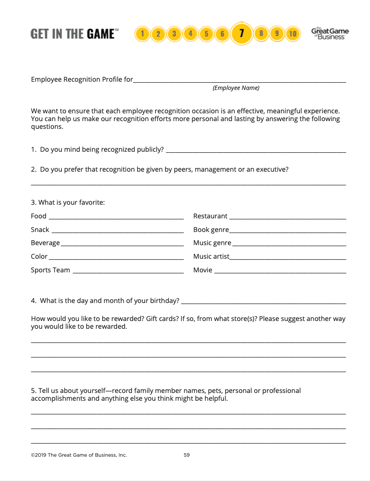What is Employee Motivation?
Employee motivation refers to the drive and energy employees bring to their work, which various factors such as recognition, rewards, job satisfaction, and a positive work environment can influence. Motivated employees tend to be more engaged, productive, and satisfied with their work, which can lead to increased organizational success. Employee Motivation is just 1 of 8 challenges to prioritize when leading through uncertain times.
Why is Employee Motivation Important?
There are many benefits to having a highly motivated workforce. Motivated employees are crucial to the success of any organization, as they are more likely to go above and beyond their job duties, provide better customer service, and work collaboratively with their colleagues. In addition, employee motivation is linked to lower turnover rates, reduced absenteeism, and higher job satisfaction, leading to improved organizational performance and increased profitability.
How Employee Motivation Affects Performance
Employee motivation plays a crucial role in determining the success of an organization. When motivated, employees are more likely to be engaged and committed to their work, resulting in increased productivity and higher-quality output. Motivated employees also tend to be more proactive, creative, and innovative, leading to a more efficient, dynamic, and agile organization that can adapt to changing market conditions. Additionally, motivated employees are more likely to stay with the organization, reducing employee turnover and recruitment and training costs. Conversely, low employee motivation can lead to decreased productivity, quality issues, and absenteeism, all of which can negatively impact an organization's performance. Therefore, organizations need to foster a culture of motivation through various means, such as providing recognition and rewards, creating opportunities for personal and professional development, and promoting a positive work-life balance.
What Happens When Employees Lose Motivation?
When employees lose motivation, their performance and productivity at work tend to suffer. They may become less engaged, less committed, and less enthusiastic about their work, leading to lower quality output, missed deadlines, and decreased efficiency. Moreover, disengaged employees may experience higher rates of absenteeism, turnover, and may be less likely to go above and beyond their job responsibilities to contribute to the organization's success. Additionally, the lack of motivation can lead to a negative work environment, which can have a ripple effect on other employees, causing them to also become demotivated. Ultimately, the loss of employee motivation can significantly impact an organization's bottom line, leading to decreased revenue, increased costs, and reduced competitiveness in the market. Therefore, it's essential for organizations to proactively address any issues that may cause employees to lose motivation and implement strategies to re-engage and motivate them.
Employee Motivation vs. Engagement
Employee motivation and engagement are related concepts but refer to different aspects of employee behavior and attitudes. Employee motivation refers to the drive and energy employees have to achieve their goals. It is the internal force that drives individuals to take action toward a particular outcome. On the other hand, employee engagement is the level of commitment and involvement that employees have towards their work, colleagues, and the organization as a whole. It measures how connected employees feel to their work and how invested they are in the organization's success. While employee motivation is essential for employees to perform their work effectively, engagement is critical for creating a positive and productive work environment. Motivation is necessary to get work done, but engagement is essential for employees to feel fulfilled and satisfied with their work. Organizations that focus on both employee motivation and engagement can create a culture that fosters employee well-being and drives organizational success.

How To Motivate Employees During Uncertain Times
Fear. Uncertainty. Economic adversity. Layoffs. A growing sense of panic every time news channels deliver bad news. Chatter around the workplace is filled with questions like: Should I get married? Can I afford to pay my rent? Will I have a job tomorrow? But what can you do when you're facing fear in the workplace today? The good news is that you can turn to four key principles of the Great Game™—transparency, trust, financial discipline, and respect for people—to help address fear and keep employees motivated in your organization.
1. Embrace Transparency
Embrace transparency and be honest about the business situation. Use "open-book management"—the idea that everyone inside the company is taught to understand the numbers that drive success, as a way to inform employees on the company's situation and what employees can do to improve the situation. Keeping employees in the loop eliminates the fear of the unknown. Instead, it motivates employees to build focus around what they can do to help make sure their workplace remains secure during economic uncertainty. Many business owners can be reluctant to open their books and share the truth about the financials of their business. However, it's a greater risk to take on the burden of keeping the company alive—solo. There have been many cases where CEOs and owners are forced to shut the doors of the business to the shock of their associates, who are then forced to wonder if they could have done something to contribute to a different outcome. "If only they had asked for help." That's why it's amazing what happens when you have the courage to share the news—the good and the bad—with your people. Treat them like adults. Get their attention directed toward what they can do to help—versus panicking. Plus, the more eyes you have on a problem, the more ideas you'll have to solve it with. It's an automatic check-and-balance on the security of your business.
2. Build Trust
Trust is vital to an organization. Without it, a company can't build meaningful, lasting relationships with employees, customers, vendors, etc. Leaders can try to reassure employees of the business's current situation, but ultimately that message will go in one ear and out the other if employees don't trust leadership. Trust can be destroyed very quickly when leadership says something that contradicts the reality of the business. That's why it's important to remain honest and authentic with employees. Don't be something you're not. Don't act like you have all the answers when you don't. People can tell when you're not being yourself, which only puts more distance between you and your employees. If you don't have all the answers, admit it. Explain to employees why you're making the decisions you are and how you're using the available information to inform those decisions. Try to include employees in as many of the company's strategic decisions as possible. This builds trust and motivation as employees feel more included. Explain that the situation may continue to change and keep employees updated.

3. Discuss the Company's Cash Position
Every business needs to have cash on hand to deal with unexpected scenarios and events. Leaders should always prioritize their cash position, because it's the one thing that will keep the doors open during a crisis. Taking on debt is NOT the only way to grow. So avoid debt as much as possible and build a cash reserve. Leaders may find themselves in an over-leveraged position. But that can also be an opportunity to engage their workforce and build trust by telling employees the truth about the company's situation. Suppose a business leader were to find themselves in trouble. In that case, they can ask their associates for ideas about how they can contribute to cutting costs—and increasing cash flow to the point where the company can cover its debt obligations. You'll be amazed at what can happen when you teach your people about the business and involve them in finding solutions. Providing employees with real-time information and the chance to make a difference will motivate employees to participate in seeing the company succeed much more than keeping them in the dark with no indication of what's happening in the business.
4. Protect Jobs
To say the past few years have been difficult to attract—and retain—people in the middle of the "War for Talent" would be an understatement. Companies won't have a future without people; they need to understand that. That's why it's crucial to protect jobs AND let your employees know that it's the company's priority to protect their jobs. Companies should avoid resorting to layoffs to survive. It does irreversible damage to the company and makes attracting top talent in the future that much more difficult. When employees know they work for an organization that values their livelihood and has their back when times get tough, they will be much more motivated to reciprocate that respect and give their best daily performance to ensure the organization succeeds. It's our belief that whoever has the most talented workforce will dominate their markets in the upcoming years.
Ways to Increase Employee Motivation
There are several strategies that organizations can use to increase employee motivation, below we've listed six ways to improve motivation in your organization:
6 Tips to Increase Employee Motivation
1. Recognition and rewards: Recognizing and rewarding employees for their contributions can be a powerful motivator. This can take the form of bonuses, promotions, or other tangible rewards, as well as verbal or written recognition.
2. Job enrichment: Providing employees with opportunities to take on new challenges, learn new skills, and take on more responsibility can increase their motivation and engagement.
3. Positive work environment: Creating a positive work environment that supports employee well-being, encourages collaboration, and promotes open communication can also increase motivation.
4. Employee involvement: Encouraging employee involvement in decision-making processes and providing opportunities for feedback can increase employee motivation by giving them a sense of ownership and investment in their work.
5. Encourage personal and professional development: Providing opportunities for employees to learn and grow can help to increase their motivation and engagement. This can be through training programs, workshops, or mentoring.
6. Promote work-life balance: Encouraging work-life balance can help employees to feel less stressed and more motivated. This can be in the form of flexible working hours, telecommuting options, or offering wellness programs.
Unique Ways Organizations Are Boosting Employee Motivation and Morale
Organizations are constantly exploring new and unique ways to motivate their employees. Here are some examples of unique strategies that companies have used to motivate their employees:
1. Unlimited vacation time: Some companies have implemented an unlimited vacation policy, where employees are given the freedom to take as much time off as they need, as long as their work is completed on time.
2. Employee-driven wellness programs: Some companies have implemented employee-driven wellness programs, where employees are given the opportunity to design and participate in activities that promote health and wellness.
3. Volunteer opportunities: Some companies have implemented a volunteer program where employees are given paid time off to volunteer at their preferred charity or organization.
4. Creative workspaces: Some companies have created unique and innovative workspaces that encourage collaboration and creativity. This can include open workspaces, comfortable lounges, and outdoor workspaces.
5. Personalized rewards: Some companies have implemented personalized reward systems, where employees can choose from a range of rewards that suit their personal interests and preferences, such as concert tickets or spa treatments.
-1.png?width=80&height=80&name=Coachs%20Tip%20Chat%20Bubble%20(1)-1.png) Download our employee recognition handout to learn how each one of your employees wants to be recognized.
Download our employee recognition handout to learn how each one of your employees wants to be recognized.


6. Peer recognition programs: Some companies have implemented peer recognition programs where employees are encouraged to recognize and reward their colleagues for their contributions and achievements.
These are just a few examples of the unique ways organizations motivate their employees. By providing a supportive and engaging work environment that meets the needs of their employees, companies can mend broken morale and help to create a culture of motivation, commitment, and success.
Ways to Motivate Employees Without Money
1. Provide feedback and support: Regular feedback and support can help employees to feel valued and motivated. Encourage open communication and provide constructive feedback to help employees improve their performance.
2. Reward with advancements: This is the most obvious and concrete form of recognition with responsibility. A promotion is a straightforward way to show team members that you value their contributions to the team.
How Do You Measure Employee Motivation in the Workplace?
Measuring employee motivation in the workplace can be challenging, as it is an internal and often intangible concept. However, there are a few methods that organizations can use to gauge employee motivation:
1. Employee surveys: Conducting anonymous employee surveys can provide valuable insights into employee motivation levels. Questions can be designed to measure employee satisfaction, engagement, and overall motivation.
2. Employee turnover rates: High employee turnover rates can be an indication of low employee motivation. Measuring employee turnover rates over time can provide an idea of how employee motivation is changing within the organization.
3. Absenteeism rates: High absenteeism rates can also indicate low employee motivation. Measuring absenteeism rates over time can provide insight into employee motivation levels.
4. Employee performance: Measuring employee performance can provide an indication of employee motivation. High-performing employees are often motivated and engaged in their work, while low-performing employees may be experiencing lower levels of motivation.
5. Employee feedback: Regular feedback sessions with employees can provide valuable insights into their motivation levels. This can include one-on-one meetings, performance reviews, and regular check-ins.
While measuring employee motivation can be challenging, using a combination of these methods can help organizations to gain a better understanding of their employees' motivation levels. This can help to identify areas where improvements can be made, and ultimately lead to a more engaged and motivated workforce.

How Employee Motivation Can Reduce Turnover
Employee turnover can be costly and disruptive to an organization. One way to reduce turnover is by increasing employee motivation. When motivated, employees are more likely to be engaged and committed to their work, leading to increased job satisfaction and a lower likelihood of turnover. Here are some ways that employee motivation can help to reduce turnover:
1. Improved job satisfaction: Motivated employees tend to be more satisfied with their work, which can lead to increased job retention.
2. Increased engagement: Engaged employees are more likely to feel a sense of purpose and belonging within the organization, leading to a more substantial commitment to their work.
3. Greater productivity: Motivated employees tend to be more productive, leading to increased job performance and greater job satisfaction.
4. Lower absenteeism: Motivated employees are less likely to be absent from work, which can help to reduce the cost and disruption of employee turnover.
5. Better workplace culture: A positive and motivated workplace culture can help to create a supportive and engaging work environment, which can lead to greater employee retention.
By focusing on employee motivation, organizations can reduce the likelihood of turnover and retain their top talent. This can ultimately lead to a more stable and prosperous organization over the long term.
The Great Game of Business and Employee Motivation
The Great Game of Business is a management approach that aims to increase employee engagement and motivation by involving employees in the financial performance of the organization. This approach involves educating employees on the financial aspects of the business, providing them with regular updates on financial performance, and encouraging them to identify opportunities for improvement and cost savings.
By involving employees in the financial performance of the organization, The Great Game of Business creates a sense of ownership and investment in the success of the organization, which can increase motivation and engagement. In addition, this approach helps to improve financial performance by harnessing the collective intelligence and creativity of employees to identify new opportunities for growth and cost savings.
In conclusion, employee motivation is essential to the success of any organization, and there are several strategies that organizations can use to increase motivation, including recognition and rewards, job enrichment, a positive work environment, and employee involvement. The Great Game of Business is one approach that can be particularly effective in increasing employee motivation by involving employees in the financial performance of the organization and creating a sense of ownership and investment in its success.
Using MiniGames™ To Motivate Employees
A MiniGame is a short-term, department or team-specific goal that is tied to the larger goals of the company. The objective of a MiniGame is to create a fun and competitive atmosphere where employees work together to achieve a common goal while learning and improving their skills. MiniGames typically run for a period of 90 days and are accompanied by regular communication and scorekeeping to track progress and performance.
To start a MiniGame, the team or department identifies a specific business challenge or opportunity that can be addressed through the game. They then develop a plan to achieve the goal, which includes specific actions, milestones, and metrics to track progress. The team then determines a reward or incentive that will be given to the team or individuals who achieve the goal.
The results of playing MiniGames have been significant. Companies that have implemented The Great Game of Business approach and MiniGames have reported higher levels of employee engagement, productivity, and financial performance. In addition, employees have reported feeling more connected to the company's goals and values, as well as feeling more empowered to contribute to the company's success. By involving employees in the business and providing them with clear goals and objectives, MiniGames can help to create a culture of ownership and accountability that drives performance and success.
In summary, The Great Game of Business uses MiniGames as a way to motivate employees and achieve short-term, team-specific goals. MiniGames are designed to be fun, competitive, and engaging, and they help employees to improve their skills while contributing to the larger goals of the company. Companies that have implemented MiniGames have seen significant improvements in employee engagement, productivity, and financial performance, making it a valuable tool for any organization looking to improve its performance and culture.


.png)



-1.png?width=80&height=80&name=Coachs%20Tip%20Chat%20Bubble%20(1)-1.png) Download our employee recognition handout to learn how each one of your employees wants to be recognized.
Download our employee recognition handout to learn how each one of your employees wants to be recognized.



